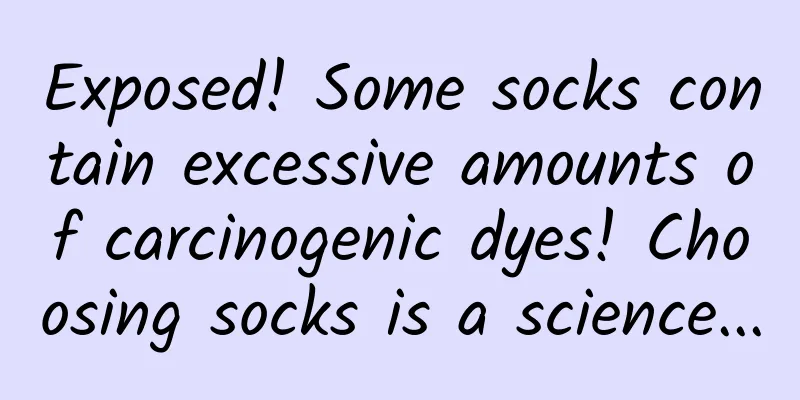Exposed! Some socks contain excessive amounts of carcinogenic dyes! Choosing socks is a science...

|
Experts in this article: Liao Jie, PhD, School of Biomedical Engineering, Beihang University Lin Na, PhD in polymer physics and chemistry, Institute of Chemistry, Chinese Academy of Sciences Recently, CCTV exposed that some "pure cotton socks" sold on some e-commerce and live streaming platforms contained excessive amounts of carcinogenic dyes, which attracted widespread attention. The test results found that not only was the cotton content seriously insufficient and the fiber content unqualified, but some dyes also contained excessive amounts of carcinogens and other quality problems. Socks are essential for all seasons. How do you differentiate between cotton socks, spandex socks, nylon socks, wool socks, etc.? And how do you identify socks that contain excessive amounts of carcinogens? Read on. Cotton socks, nylon socks, wool socks…what’s the difference? Cotton socks are sweat-absorbent, breathable, soft, easy to clean and not prone to pilling, so many consumers unconsciously believe that only "pure cotton" socks are the best. In fact, natural cotton yarn has very poor elasticity, and 100% cotton socks have a very high shrinkage rate and are not durable. Therefore, in order to make socks comfortable, fit and not easily damaged, cotton socks will be blended with a certain proportion of other fibers. Spandex, nylon, acrylic, polyester, etc. are all very common functional fibers. What are the differences? 1. Combed cotton Combed cotton is the long and neat cotton fiber left after the shorter fibers in ordinary fibers are removed by combing machine. Features: It is more delicate, smoother and more comfortable to the touch, and is a mid-to-high-end cotton product. 2. Mercerized cotton Mercerized cotton refers to cotton fibers that have been mercerized in a concentrated alkaline solution. Features: better gloss, shiny, and not easy to wrinkle. Usually seen in thin socks in summer. 3. Acrylic cotton Acrylic cotton is a blended yarn (usually blending can complement the shortcomings of the two raw materials). Acrylic is known as "artificial wool". Features: soft, bulky, not easy to dye, bright color, light-resistant, antibacterial, not afraid of insects, etc. The commonly used acrylic cotton content ratio is 30% acrylic and 70% cotton, which has the function of cotton absorbing sweat and deodorizing. 4. Spandex Spandex is commonly known as elastic fiber. Features: Socks with spandex can produce elasticity and retraction, and are easier to wear, so that the socks can fit the feet better and not slip off. Among spandex fibers, there is a material called "friendly" fiber - Lycra. Its advantage is that it can stretch up to 500%, and can recover to its original shape and stick to the human body surface. It has little restraint on the human body and is very flexible when worn and moved. 5. Nylon Nylon, also known as nylon, has the following characteristics: good dyeability, light to wear, good waterproof and windproof properties, high wear resistance, good strength and elasticity, easy to wash and dry, strong and durable, good stretchability, and a variety of colors, but it does not absorb sweat and has poor breathability. Ordinary socks other than stockings made from them are prone to causing smelly feet. 6. Polypropylene Polypropylene refers to polypropylene fiber. Features: light texture, weak moisture absorption, but very strong perspiration function. Wear-resistant and stretch-resistant, so it is often seen in sports socks. 7. Wool It is mainly composed of an insoluble protein, with good elasticity, full feel, strong moisture absorption, good warmth retention, not easy to stain, soft luster, excellent dyeability. Due to its unique shrinkage property, it generally needs to be treated with shrink-proofing to ensure the size of the fabric. The disadvantage is that it is not easy to dry. 8. Rabbit Fur The fiber is soft, fluffy, warm and has good moisture absorption capacity, but low strength. Most of them are blended. The commonly used rabbit hair content ratio is 70% rabbit hair and 30% nylon. Are these ingredients actually carcinogenic? Various dyes and additives are added when socks are made. Some chemical products are harmful to the human body, and some are even carcinogenic. Azo dyes Currently, more than 70% of the dyes used for dyeing leather and textiles are azo dyes, and even the dyes in many foods are azo dyes. Azo dyes themselves do not have any direct carcinogenic effect, but the aromatic amines reduced from azo dyes are potentially carcinogenic to humans or animals. Azo dyes on textiles are transferred from textiles to human skin during long-term contact with the skin under certain special conditions, especially when the color fastness is poor. Under the action of human secretions, they undergo reductive decomposition reactions and release carcinogenic aromatic amine compounds. After being absorbed by the human body, they will cause changes in human DNA, eventually causing human lesions and even inducing cancer. In 2003, my country issued GB18401-2003 "National Basic Safety Technical Specifications for Textile Products", which officially included banned azo dyes. It is recommended that when purchasing textiles, especially black or dark-colored clothing, you try to go to regular shopping malls to buy clothing with safety labels, or pay attention to whether there are Chinese characters indicating "in compliance with GB18401 standards" on the tags and product labels. formaldehyde Formaldehyde can form a protective layer on the sample, which has the functions of no ironing, shrinkage-proof, wrinkle-proof and easy to remove stains. However, excessive formaldehyde can be harmful to human health: 1. It has a strong irritating effect on the skin and eye mucosa. If there is excessive formaldehyde in textiles, it will be gradually released during the wearing process, causing harm to the human body through the skin and respiratory tract, especially easy to irritate the skin and respiratory tract of infants and young children. 2. When children wear clothes with excessive formaldehyde, their bodies are affected. Mild symptoms include tears, coughing, contact dermatitis, pain in fingers and nails, etc. In severe cases, they may experience insomnia, dizziness, headache, etc. 3. Wearing clothes with excessive formaldehyde for a long time and inhaling low doses of formaldehyde gradually accumulates, which can also cause chronic respiratory diseases, conjunctivitis, pharyngitis, asthma, bronchitis and other diseases, and may even induce cancer. Because formaldehyde is irritating, easy to identify, and easily soluble in water, most of the formaldehyde can usually be removed by washing with water and then ventilating and drying. Therefore, it is recommended that you buy socks and wash them before wearing them instead of wearing them directly. What should I pay attention to when buying socks? A good pair of socks can absorb sweat, keep warm, and relieve friction between the feet and shoes. Some socks also have shock-absorbing, joint protection, and antibacterial functions. 1. Don’t be greedy for cheap things. Try to choose products sold by regular companies and pay attention to the product labels. Usually, socks with a cotton content of more than 75% can be called pure cotton socks, and socks with a cotton content of 85% are very high-end cotton socks. 2. It is best to wash newly purchased textile clothing first to reduce the impact of the fabric's pH or color fading on human skin. 3. For products with dark or bright colors, you can use white cloth to rub the product. If the color fades obviously, or if it fades severely when washed after purchase, it may be that inferior dyes were used and the color fastness is not up to standard. It is not recommended for use. 4. Harmful substances such as formaldehyde are relatively easy to detect, but some chemicals that may pose potential health risks cannot be identified by color or smell. Therefore, when purchasing, you can ask the merchant to check whether the product has a test report from a regular testing agency. The pictures in this article with the "Science Popularization China" watermark are all from the copyright gallery. The pictures are not authorized for reprinting. |
<<: What amazing skills do sea snails, known as “global travelers,” have?
>>: With frequent volcanoes, will the next "Pompeii Doomsday" appear?
Recommend
IDC: iPhone shipments to grow at more than twice the rate of Android devices in 2021
According to the latest forecast report released ...
Interesting Talk: Can Time Travel Prolong Life? Scientific Interpretation: It's Just an Illusion
We often see such descriptions on the Internet: i...
Samsung Galaxy S6 Close-up: Metal body and curved screen
With the precedent of GALAXY S5 released at MWC l...
The world's most powerful laser is activated! What is chirped pulse amplification technology?
The world's most powerful laser is activated!...
Can consumption be doubled by optimizing information flow using these 3 copywriting tricks?
Today we are going to talk about the black techno...
With domestic science fiction novels winning awards one after another, how long will the corresponding games remain silent?
The Hugo Award is like the Nobel Prize in the sci...
Zhou Fan | Turning Life 365 to Build a New Self Online Course 24 Video Lessons
Zhou Fan | Turning Life 365 to Build a New Self O...
Practical Investment Course - Investment Banking Yue Nu Jian Baidu Cloud Download
Practical Investment Course--Introduction to Inve...
Youzi operates two hours a day and earns more than 1,000 yuan a day.
This project was created when I was researching p...
Google Glass can be used to steal passwords with 90% accuracy
The latest research results from the University o...
E-commerce operation copywriting skills, how to improve product selling points?
For the current e-commerce platforms such as Tmal...
Baidu's bidding bid is the highest, but the ranking is not the highest. What's going on?
(1). It seems that your keyword quality is less t...
"How did a deer from across the ocean end up on our national emblem?"
This is the national emblem of Antigua and Barbud...
Zheng Xiangzhou-New Business Model Complete Works Value 12980
Zheng Xiangzhou-New Business Model Complete Works...
These 10 little things are not selfish even if you do them!
We have been taught since childhood not to be &qu...









